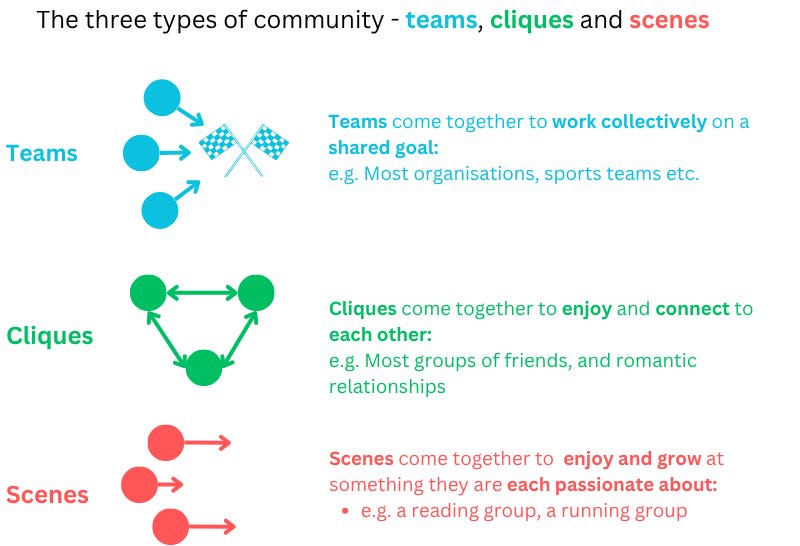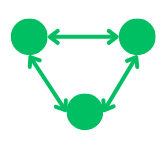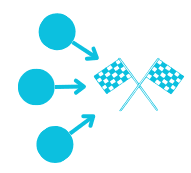Ontological status: Yes, this is ontology
Groups of people are one of the most important things. If I were to list all the things and rank them by importance, groups of people would be near the top. Love, truth and freedom and other such things might score higher from some angles, but these things are usually found in groups of humans anyway.
And groups are complex. That’s why I started using this categorisation of groups recently. I have found it very helpful in conversations about community and events over the past year.[1]
For any set of things, there are usually many ways of categorising it. Rather than size, or the specifics of what folk do together (though they are important), I like thinking of groups in terms of the flavour of their purpose!
Here’s the model:

What is a scene?

The purpose of a scene is to enjoy, or grow in relation to a topic. This would include “communities of practice”, where practice is very broadly defined and could include things like playing social deduction boardgames or enjoying the music Nils Frahm. A scene could also be about some set of ideas - so "community of praxis" - where theory and practice merge, might be better.
Scenes are the most flexible and easily formed groups. They require the least coordination to get started and they can usually deliver value to members immediately. They’re driven by shared interests, skills, or passions - whether it’s a hobby, a particular topic, or simply the enjoyment of a thing. Crucially - folk in a scene are individually passionate about the thing before the group even exists - that’s why they are there.
Examples:
- A group of people who love board games. They start meeting casually to play and discuss strategies.
- A writing club where members gather to share and critique each other’s work.
- A coding meetup where people come together to learn and collaborate on projects. The draw is the shared activity, the joy of connecting over something they love, and the opportunity to improve
- An open-to-anyone online community (e.g. LessWrong)
- The Effective Altruism (EA) community is, (alongside other social/intellectual movements) most broadly, a scene - where the shared interest and praxis is “doing good better”. Individuals learn from each other about this shared interest. Folk in movements like EA do develop friendships (cliques) or start projects/orgs (teams) from within the scene - but those aren’t The EA community - those are cliques and teams that the EA scene has produced.
What is a clique?

The purpose of a clique is to enjoy each other and enjoy being a part of the clique. Cliques are communities of belonging. This means that a clique is as stable and powerful as the strength of its boundaries. i.e. what it is that defines this group, the people in it and how does that change in time. This could be as simple as being 1 of the literally these 5 specific people in the case of a group of friends, or could be about genetic/legal connection as is the case in most families. Cliques will generally involve a higher degree of interpersonal connection, relational-dependence and intimacy than scenes or teams (because that is their purpose). Unlike scenes, which tend to be fairly open, cliques are defined by their exclusivity - membership is generally intentional, and crossing the boundary into or out of the group is very meaningful. Compared to scenes and teams, they are often inwards looking - they are about connection and finding joy in coexisting with others for its own sake.
Examples:
- A family - the archetypical clique
- A romantic relationship
- A group of friends
- An intentional shared house
- A group of people actually at an event (during the duration of the event)
- I think this is a helpful framing for a lot of events and why good events designers and producers talk about the “container” a lot - clear common knowledge of who is in the group and why creates a stronger clique and therefore more potential for psychological safety, belonging and intimacy (which are inherently good and also useful for other things that are good).
What is a team?

The purpose of a team is to achieve a shared goal. Unlike scenes or cliques, teams exist to achieve something shared and specific, and their structure reflects this focus. Roles are often clearly defined, and the success of the group depends on coordination, accountability, and mutual trust. They often also need clear boundaries (e.g. clear recruitment requirements in the case of an organisation), but could also be more diffuse if the need for coordination is lower, or if coordination is facilitated by a functional set of systems and norms (e.g. a group who are all working on some open source software).
Examples:
- A business or charity
- A project team
- A leadership team for a scene
- Two parents in their role of raising a child
- Two people who decide to share the job of doing the washing up at the end of a party.
Some mistakes and hard-earned takes
I hope the above is valuable to you. My core take is that identifying what you are part of, or trying to build, should influence how you choose to build, lead, participate in a community.
That said, here are some more specific mistakes I and others I know have made, and the (more tentative) takes that have resulted from those past mistakes.
Mistake 1: Being too democratic, too early, in scenes
- Scenes grow and persist when they have teams that steward them (i.e. a subset of the group with a shared goal of supporting the scene)
- Unlike cliques or teams, folk are usually not very emotionally or financially dependent on scenes (especially early on, when no cliques have developed in the scene). This means the risks of having a highly empowered leader or leadership team is low. People can just leave.
- The main risk to a scene is lack of leadership, or a drop in leadership energy or motivation. This might just be fine, nothing lasts forever, but I’ve tried and failed to build scenes in the past through lack of prioritising my own vision and interest as a leader.
- Sensitive leadership - i.e. establishing and meeting the needs of people in the group is obviously still very good, even if you others aren’t directly empowered.
- Having a strong lean towards meeting the needs of more central, regular group members here is also super important - I’ve seen scene leaders do this explicitly (e.g. prioritising the needs of people who’ve been to X events over those that have been to fewer) and this seems very good for scene health (though some folk will complain).
- The flip side of this, being too hierarchical or dictatorial in cliques also seems bad.
Mistake 2: Trying to get a sense of belonging from a scene (or mistaking a scene for a clique)
- Scenes are generally more brittle and have more instrumentality than cliques. A scene is less intrinsically valuable than a clique and if the scene didn’t exist, folk would just do something else.
- Scenes do produce cliques, and a whole scene might transition into a clique (e.g. your film watching group stops being about the films after a few months and you just start hanging out).
- Though worse than cliques, teams are a better place to get belonging than scenes. But since that belonging will often be based on your instrumental value to the shared mission (e.g. you get to belong in your company because of your spreadsheet skills), it seems like a relatively precarious and limited place to meet this need.
- I definitely did this with the EA community when I first got involved. This was understandable as I had moved to a new city and didn’t have much belonging in my life, but made me quite neurotic about the scene for a while…
Mistake 3: Not setting clear boundaries in cliques (mistaking a clique for a scene)
- The boundary is one of the most important elements of a clique - many have natural boundaries (e.g. families, or homes). Creating common knowledge about boundaries and respecting them seems neglected in many cliques.
- E.g. Bill letting his new boyfriend join your weekly hang is a thing it’s very reasonable to be very careful about. Lack of intentionality in clique boundary crossing erodes belonging.
- I love opening circles at events and think they are extremely powerful for this reason - when everyone can see everyone seeing everyone, you create common knowledge of who is and isn’t in the group - this build belonging, especially when the circle also clarifies and emphasises the shared reason for being there.
Mistake 4: Treating a scene like a team
- Teams require a lot of buy-in, trust, communication and a clear shared vision on what is being achieved. Scenes are usually more fluid, opt-in, and porous. You can create a scene that tries to achieve things collectively (e.g. hackathons often feel like this), but in my experience, the friends (cliques), skills, and experiences made along the way are much more valuable than the tangible output of goal-oriented scene-building.
- This is true of EA - Occasionally I see people framing the whole scene as having a shared mission (less suffering or something) which I think is not 100% false, but feels like a disorientating frame to me, and implies a greater need for buy in, trust and mutual dependence than a scene can realistically hold.
Mistake 5: Trying to force a clique
- Most folk make friends at school or work for a reason - you have a clear reason to be together that allows trust to be built and relationship tested over time. It’s hard to force this.
- If you’re trying to build a clique, you’ll want to go slowly. Cliques meet some of the deepest psychological needs in our biology and some of the least met needs in our culture (love, belonging). They trigger everyone’s attachment wounds.
- Consider starting, or joining, a scene first - allow folk to spend time with each other in a lower pressure environment.
- (Something in here is at the core of why I found internet dating unpleasant, and imagine others do too - you’re trying to start a very important clique from scratch…)
Some final points
“Reality doesn’t come in categories” - individual groups often contain elements of multiple types. A group might be both a scene, and a clique (though it’s still valuable to know how much of dynamic is present and which flavour is most dominant)
“Everything comes from everything else” - groups of people are fractal. With groups within groups within groups - A team might house a scene, which in turn can foster a clique, and vice versa.
The best events know what type of community they are cultivating. Every event is about the cultivation of some kind of group. Sometimes this is ephemeral, and just about the time at the event. But the most important events I’ve been part of, transform the shape of the group beyond their start and end time. Knowing what flavour of group the event is supporting is therefore crucial.
This framework has become really helpful for me in talking about community building and events. It helps clarify what I’m doing. I also think it might be really helpful for making sense of the communities that you’re in, and identifying failures in leadership.